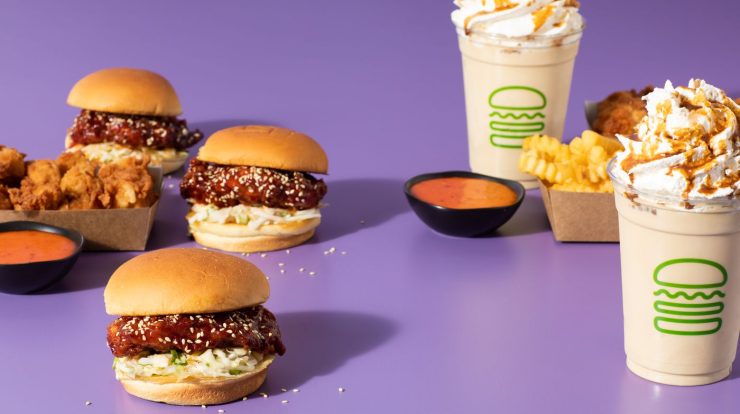
Crowd-favorite burger chain Shake Shack has come under fire after a new, limited-time “Korean-style” menu of chicken sandwiches and sides drew accusations of cultural appropriation for its loose interpretation of Korean fried chicken.
The menu debuted nationwide one week ago and features a sandwich with gochujang-glazed fried chicken and a white kimchi slaw; nuggets and fries served with a gochujang sauce; and a black sugar vanilla shake. Shortly after the reveal, some people criticized the company online for appearing to engage in cultural appropriation. Other social media users argued that adding items like kimchi and a gochujang sauce to a couple of menu items and labeling it “Korean-style” fried chicken was a lazy interpretation of the beloved food. Others encouraged diners to visit local Korean restaurants in their neighborhoods instead. “Yes, slap some gochujang on something and it’s korean,” Giaae Kwon, a Brooklyn-based writer, tweeted.
Kwon, who first heard about the sandwich when it debuted at Shake Shack locations across South Korea last year, tells Eater New York that the menu launch in the U.S. looked “like the most basic way to go about doing a Korean fried chicken.”
Others echoed the sentiment. “It feels like white people slapping together a bunch of things because they perceive it as Korean and then profiting off of those things,” says Dash Kwiatkowski, a standup comedian and podcast host based in Providence, Rhode Island, who also tweeted criticism of Shake Shack’s new menu. “What makes it ‘Korean-style?’ Is it the fact that they put kimchi on a fried chicken sandwich? Because that’s not Korean-style fried chicken.”
The U.S. launch was an iteration on a popular gochujang fried chicken sandwich that had sold well at the chain’s 14 shops in South Korea last fall, according to the company. The sandwich recipe was adjusted slightly for the stateside launch, including adding a white kimchi slaw using kimchi from Portland, Oregon-based Choi’s Kimchi Co.
Kwiatkowski and Kwon both noted that it was nice to see the chain partnering with a small, family-owned shop to source the kimchi, but were disappointed to see that the hip, NYC-based chain — which often engages in buzzy chef collaborations — did not choose to partner with a Korean restaurant or a Korean chef to help launch the menu in the U.S.
In a phone interview, Shake Shack culinary director Mark Rosati said that his team, along with employees from SPC Group — a gigantic food company based in South Korea that partnered with Shake Shack in 2015 to help it expand in the country — toured a range of fried chicken restaurants in Seoul while they were developing the chain’s sandwich, including Hanchu, Hyodo Chicken, Ungteori Tongdak, and Jung-ong Sweet & Spicy Chicken. They also sourced information on fried chicken and Korean food in general from food writers and influencers Matty Yangwoo Kim (@hungrymatty) and Jason Kim (@mykoreaneats). But none of that information made it into the announcement for the U.S. launch.
“I would love to hear what that research looked like,” Kwiatkowski says. “If you’re going to try to package someone else’s culture as a fast-food item, the very least you could do is really elevate someone from that culture, elevate some specific chefs and specific restaurants.”
In response to the criticisms of cultural appropriation levied online, Rosati says that he could “definitely see how someone might think this here” with the new menu launch. “I can understand to a point but I can never fully understand it, because it’s not my culture,” Rosati says. “It’s something that we want to listen to, and understand.”
This particular launch marks the first time that Shake Shack has taken a menu item that has performed well at one of its international locations and reinterpreted it for a nationwide rollout in the U.S., according to the company. The sandwich has been a work in progress for the past five years, Rosati says, and it debuted at Shake Shacks in South Korea late last year. The recipe was developed in collaboration with SPC Group.
When the sandwich appeared at Shake Shack’s South Korea locations, the item was labeled as a “Gochujang Chick’n Sandwich,” attaching a straightforward title to the menu item. In the U.S., the nuggets and fries included in the new menu are labeled as “Korean Gochujang Chick’n Bites” and “Korean Gochujang Fries,” while the sandwich appears on menu boards as a “Korean-style Fried Chick’n.”
That broad, flattening name of the sandwich, employed as a catch-all term lacking nuance or context, missed the mark, says NYC Korean restaurant owner Bobby Yoon.
“If you think about wasabi, or teriyaki sauce, or some kind of a Chinese food, [it’s not labeled] as ‘Chinese-style,’” Yoon, the owner of Midtown Korean restaurant Yoon Haeundae Galbi, says. “They usually say, like, ‘teriyaki chicken,’ or ‘wasabi-flavored.’ But they don’t just put it as, like, ‘Japanese-style.’” In the same way, Korean food in the U.S. is so varied, Yoon says, that labeling a gochujang-sauced fried chicken sandwich with a blanket term like “Korean-style” does a disservice to the myriad flavors and preparations of Korean food.
“I’m not saying that anybody is doing a wrong thing,” Yoon says. “But I think that if they wanted to put it as the name [of the sandwich], I think that they should have put it as ‘gochujang’ or whatever they think that the Korean style is.”
Shake Shack’s Rosati says that, moving forward, the team is “listening” to responses to the menu items, but they’re not implementing any changes based on what they’ve heard so far. “We call it ‘Korean-style’ because it’s our take on a traditional Korean fried chicken sandwich, and is a slight variation to the one served in our South Korea Shacks,” he says.
The company purposefully used “Korean-style” and “Korean-inspired” in all of the marketing for the launch in order to signify that the sandwich was not actually an example of Korean fried chicken, Rosati says, which is generally twice-fried and dressed with a range of sauces and toppings. “It’s such a broad category,” Rosati says. “For us, it’s important to say, this is a variation of it. This is something that we draw inspiration from. This is not definitive Korean fried chicken.”
For some, the menu may have been more well-received if “it looked like they had done more thinking, and it looked like they were not just trying to profit off of [Korean food], but using their platform to really open people’s minds,” Kwiatkowski says. “I’m just saying that people should be more thoughtful and more respectful and really try to figure out how to elevate marginalized voices.”






